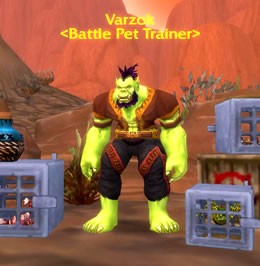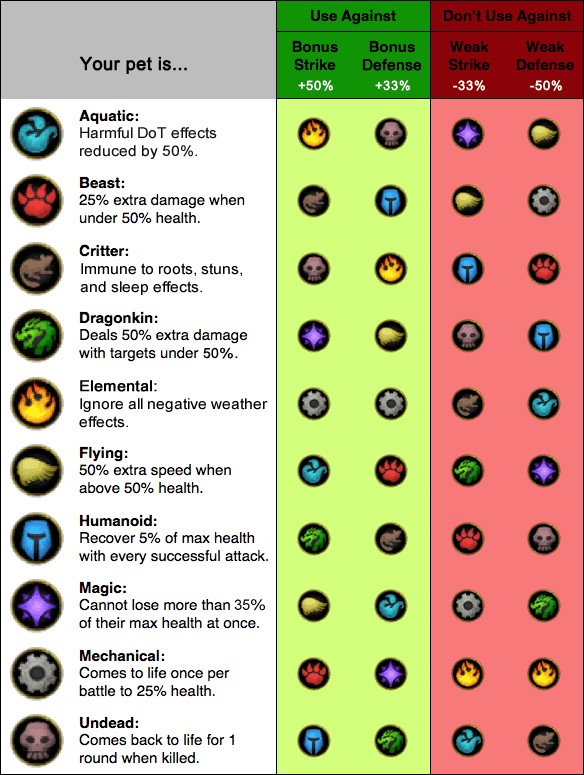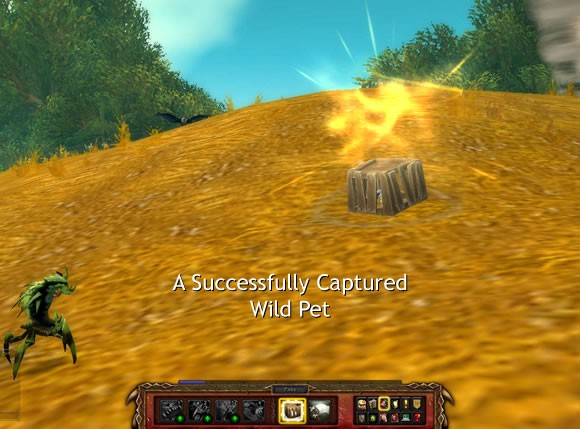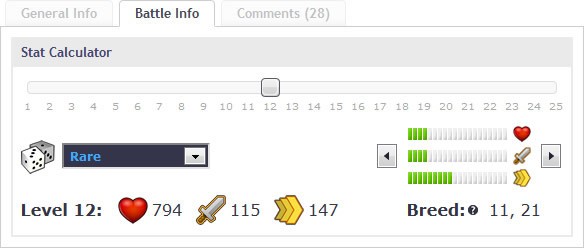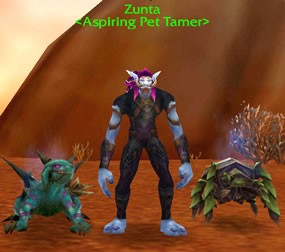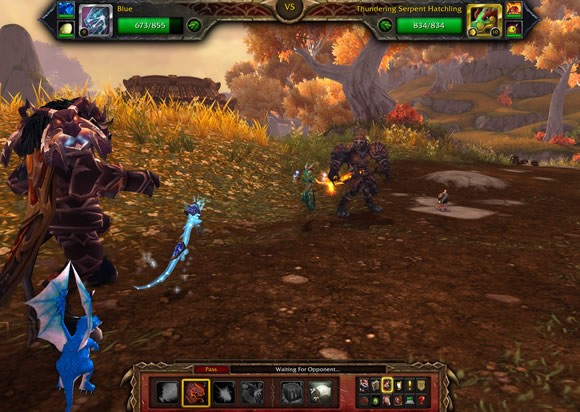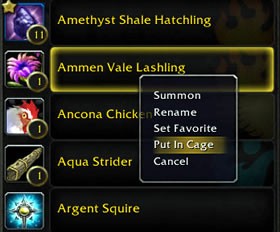At PETS.EDU.VN, we understand your enthusiasm for World of Warcraft (WoW) and the captivating world of Pet Battles. Learning How To Do Pet Battles In Wow opens up a fun and strategic mini-game, allowing you to collect, level, and battle with adorable companions. This guide dives deep into the mechanics, strategies, and resources needed to master Pet Battles, ensuring you rise through the ranks as a formidable pet battler. From understanding pet families and abilities to capturing rare wild pets, we’ve got you covered with the most comprehensive information available. Get ready to embark on an exciting journey filled with adorable creatures and tactical combat.
Let’s explore the ins and outs of becoming a pet battle master, covering everything from basic training to advanced strategies, all while enhancing your overall gaming experience and understanding of in-game systems.
1. Getting Started with WoW Pet Battles
Becoming a pet battle master in World of Warcraft starts with some simple steps. First, seek out a Battle Pet Trainer in one of the lower-level starting zones, Stormwind, or Orgrimmar. These trainers are your gateway to understanding the basics and getting your team ready.
1.1. Training and Basic Skills
These trainers will teach you Battle Pet Training for a small fee, and how to Track Pets on your minimap. The minimum level requirement to begin Battle Pet Training is level 5. The best part? Once you’ve learned how to battle on one character, all your other characters also receive the training.
1.2. Race-Specific Starter Pets
Don’t forget to grab a race-specific pet from the trainer if you don’t already have one in your collection. They will offer the pet that is specifically designated for your race, giving you a head start in your pet battling journey. While the trainer only offers your race-specific companion, you can collect all these pets by finding them in the auction house or creating characters of different races. Learn the pet with the new character, then delete it; the pet stays in your collection. Here’s a list of each race’s trainable companion:
| Race | Pet |
|---|---|
| Human | Calico Cat |
| Orc | Brown Snake |
| Dwarf | Rabbit |
| Night Elf | Moth |
| Undead | Cockroach |
| Tauren | Prairie Dog |
| Gnome | Mechanical Squirrel |
| Troll | Parrot |
| Blood Elf | Mana Wyrm |
| Goblin | Rat |
1.3. Unlocking Your First Battle Pet Slot
After training, the first slot in your Pet Battles team unlocks. Select a companion from your Pet Journal and drag it into the first space under Battle Pet Slots to activate it. You can unlock the other two slots by completing the achievements Newbie and Just a Pup.
1.4. Learning to Revive Pets
Before diving into the pet battle world, speak with your trainer again to learn the ability Revive Battle Pets. This spell is essential for healing and resurrecting your wounded pets, making it easier to keep your team in top shape.
2. Pet Tracking and General Combat
Understanding how to track pets and engage in combat is crucial for successful Pet Battles. Let’s explore the mechanics that govern these aspects of the game.
2.1. Tracking Wild Pets
The ability to track wild pets allows you to identify which critters can be captured. When tracking is enabled, a green paw print appears on your mini-map if a wild pet is nearby. This icon also appears above any critter that can be battled and caught.
2.2. Engaging in Pet Battles
To initiate a battle, right-click on the critter you wish to challenge. This will transport you to the Pet Battle UI. Remember, you cannot start a Pet Battle while in combat, and any attacks from players or nearby creatures will interrupt the battle.
2.3. Choosing the Right Battle Location
Ensure that the area where you start the battle is flat and clear. Obstructions like houses or large boulders can prevent the battle from starting. Sufficient ground space is also necessary.
2.4. Understanding the Battle Environment
During the fight, creatures in the immediate area become invisible to you, though they can still attack if they wander too close. Be aware that other players can still see and attack you, especially in player versus player (PVP) zones. Additionally, other players can watch your pet battle in real time, observing the pets involved and their health.
2.5. Navigating the Pet Battle UI
The Pet Battle UI provides essential information: your active pet’s abilities, your opponent’s health, stats, quality, and available actions. It also includes options to switch pets, pass a turn, capture a pet, or forfeit the match.
The golden border and speed mini-icon around a pet’s portrait indicate its initiative, determining who attacks first each round. Initiative is based on speed; the pet with the higher speed stat goes first.
2.6. Utilizing Your Pet-Powered Arsenal
Each pet has six abilities but can only use three during a battle. These abilities are arranged in three active spell slots. The first spell slot is unlocked by default, while the second and third unlock as the pet levels up.
Each slot has two spell options that you can switch between outside of battles. To change an active ability, click on the pet’s active slot in your Pet Journal and select the desired ability from the drop-down menu.
Hovering over an ability shows a tooltip indicating its effectiveness against certain pet types. Similarly, hovering over the opposing team’s pets displays their attacks during combat. This helps you strategize by pitting your strong pets against the opponent’s vulnerable ones.
2.7. Mastering Pet Battle Mechanics
Combat is turn-based with no time limit in Player versus Environment (PVE) Pet Battles. Take your time to decide which spell to use next. Some pet abilities have multiple round cooldowns, while others deal extra damage under specific conditions. Experiment with different attack combinations to discover the most effective strategies against various wild pets.
2.8. Switching Pets Strategically
If your pet’s health is low or its attacks are ineffective, switch it out with another companion on your team. Only pets in your three Battle Pet Slots can be switched in and out. After the match, change your active pet team, especially if some pets are low on health or have been defeated.
2.9. Earning Experience and Leveling Up
Each won battle grants experience to participating pets. However, defeated pets do not receive experience, so keep them alive by swapping them out. Experience gains depend on your pet’s level relative to the wild pet. Defeating higher-level opponents grants more experience but presents a tougher challenge. Remember, capturing a pet yields less experience than defeating it, so prioritize killing opponents if leveling up is your goal.
3. Healing Your Battle Pets
Keeping your battle pets in top condition is vital for continuous success. There are several ways to heal and resurrect your companions, ensuring they are always ready for the next battle.
3.1. The Revive Battle Pets Spell
The primary method for healing your pets is the Revive Battle Pets spell. This spell heals and resurrects all pets in your Pet Journal, including those in your active team. However, it can only be used out of combat and has an 8-minute cooldown, so use it wisely.
3.2. Stable Masters
Stable Master NPCs can heal and revive your pets for a small fee. Unlike the Revive Battle Pets spell, there is no cooldown on the Stable Master’s heal. You can find Stable Masters in major towns and cities throughout Azeroth.
3.3. Battle Pet Bandages
If the Revive Battle Pets spell is on cooldown and you can’t find a Stable Master, the Battle Pet Bandage is another option. It is a random drop from the Sack of Pet Supplies, which you can obtain by defeating NPC Pet Tamers. This bandage functions similarly to the Revive Battle Pets spell but does not have a cooldown. Battle Pet Bandages are bind-on-account, allowing you to move them between your characters. They are also stored in stacks of 25.
3.4. Initial Cooldown Lock-Out
Both the Revive Battle Pets ability and the Stable Master’s heal are subject to a 3-minute lock-out upon logging in. This prevents players from rapidly switching characters to use these healing abilities since the cooldown is not shared between characters.
4. Battle Pet Families and Abilities
Each pet in World of Warcraft is categorized into a family, influencing their strengths, weaknesses, and passive bonuses. Understanding these families is essential for strategic pet battling.
4.1. Pet Families
There are ten pet families in total: Aquatic, Beast, Critter, Dragonkin, Elemental, Flying, Humanoid, Magic, Mechanical, and Undead.
Each pet family has unique strengths, weaknesses, and a passive bonus, which help you plan stronger attacks and defend against vulnerabilities.
4.2. Strong vs. Weak Matchups
Certain pet families are stronger or weaker against others, influencing the outcome of battles. Strong attacks receive a 50% damage increase, while weak attacks suffer a 33% damage penalty.
| Attacking | Defending | Beast | Dragonkin | Flying | Magic | Undead |
|---|---|---|---|---|---|---|
| Beast | x1.5 | x0.66 | ||||
| Dragonkin | x1.5 | x0.66 | ||||
| Flying | x0.66 | x1.5 | ||||
| Magic | x0.66 | x1.5 | ||||
| Undead | x0.66 | x1.5 |
4.3. Passive Pet Family Bonuses
Each family provides a passive bonus that can significantly impact battles:
- Aquatic: Harmful damage-over-time effects are reduced by 50%.
- Beast: Deals 25% extra damage below half health.
- Critter: Immune to roots, stuns, and sleep effects.
- Dragonkin: Deals 50% additional damage on the next round after bringing a target’s health below 50%.
- Elemental: Ignores negative weather effects.
- Flying: Gains 50% extra speed while above 50% health.
- Humanoid: Recovers 4% of their maximum health if they dealt damage this round.
- Magic: Cannot be dealt more than 35% of their maximum health in one attack.
- Mechanical: Returns to life once per battle, returning to 20% health.
- Undead: Returns to life immortal for one round when killed.
4.4. Ability Strengths and Weaknesses
Pet abilities are also categorized by type. A companion typically has spells corresponding to its family, but some pets have unique abilities from different groups.
For instance, the Azure Whelpling is a Dragonkin but has Beast, Magic, and Elemental abilities. Having a diverse spell selection can prepare you for various opposing teams.
5. Capturing Wild Pets
Capturing wild pets is a key aspect of building a diverse and powerful team. Here’s how to successfully trap these creatures and add them to your collection.
5.1. The Capture Process
Most PVE battle pets you encounter in the wild can be captured. To do so, reduce the pet’s health to below 35% and use the Trap ability when it becomes available. Using Trap consumes your turn for that round. You can only capture one companion per team of wild pets, so choose wisely.
5.2. Avoiding Accidental Kills
When trying to capture a wild pet, be cautious not to kill it. Your objective is to reduce its health below 35%. Avoid using strong attacks once the pet’s health drops below 50%.
5.3. Identifying Capturable Pets
Not all pets that join a wild pet’s team can be captured. Check the Pet Journal to see if the pet is listed; if not, it likely cannot be captured. However, most pets can be trapped.
5.4. Persistence Pays Off
Sometimes your trap may fail. The good news is that the chance of failure decreases with each attempt. In some cases, you may need to reduce the wild pet’s health again for it to be eligible for capture. Completing certain achievements rewards upgraded traps, which increase your chances of a successful capture.
5.5. PVP Encounters and Pet Battles
Engaging in a wild pet battle phases you out of the environment, making wildlife invisible. However, this doesn’t make you invulnerable. In PVP zones, other players can still attack you, breaking you out of the battle. You will receive a 3-second damage shield that absorbs 50% of incoming attacks. The wild pet you were battling will respawn after you exit combat with the other player. If you defeated the primary pet before the interruption, the pet and its team will not respawn.
Note that participating in Pet Battles does not automatically flag you for PVP on a PVE server. Only PVP zones like Tol Barad or Wintergrasp will flag you for player versus player combat. On PVP servers, everyone is fair game.
5.6. Receiving Your Prize
Your trap might fail a few times, so be persistent and patient. Each wild pet you capture has a random set of battle stats based on its quality and breed.
Pets of certain levels will “weaken” after being captured:
- A level 16 to 20 wild pet loses 1 level when caught.
- A level 21 to 25 pet loses 2 levels when caught.
If you are unsuccessful in battle, any wild pet you managed to trap is lost. To keep any trapped pet, you must win the overall battle. If you trap the first opponent but lose to the second, the first pet is lost, and you must try again with another wild pet.
6. Battle Pet Quality
Understanding battle pet quality is crucial for optimizing your team’s performance. Pet quality affects their battle stats, influencing their effectiveness in combat.
6.1. Quality Tiers
Battle pets come in several qualities, each represented by a different color:
- Poor: Gray
- Common: White
- Uncommon: Green
- Rare: Blue
- Epic: Purple
- Legendary: Orange
Currently, pets with epic and legendary qualities are not accessible to players, but Blizzard intends to implement them in the future. Some high-level Master Tamer NPCs have pets of these qualities. Also, certain legendary pets are objectives for the Beasts of Fable daily quest, but you cannot capture them.
6.2. Impact on Battle Stats
Higher-quality pets have better health, speed, and attack values. These stats also scale better as the pet levels up. Even among pets of the same quality, stats can vary due to different breeds. For example, one uncommon cat might have more health but less power and speed than another uncommon cat.
6.3. Stat Calculator
Each battle-ready pet on PETS.EDU.VN has a “Battle Info” tab with a stat calculator. This tool allows you to adjust the pet’s level and rarity to see its stats.
You can also cycle through available breeds (some pets only have one breed) to tweak the pet’s overall stats.
6.4. Wild Pet Quality
The quality of captured wild pets is random. As of patch 5.1, the Pet Battle UI displays a wild pet’s quality (indicated by a color-coded border) upon entering battle. If you are farming for a specific quality and forfeit the match, your team incurs a small damage penalty (around 10%). There is no reliable way to determine a pet’s quality before the start of a battle.
6.5. Non-Wild Pet Quality
Many rare World drops and special non-wild companions have boosted stats based on their quality. For example, the world-drop dragon whelps (Azure Whelpling, Crimson Whelpling, Dark Whelpling, and Emerald Whelpling) are of rare quality. Check your Pet Journal to see the color-coded rarity of your non-wild pets.
6.6. Upgrading Pet Quality with Battle-Stones
Battle-Stones, introduced in patch 5.1, allow you to automatically upgrade pets to uncommon (via Polished Battle-Stones) or rare quality (via Flawless Battle-Stones).
There are two types of each stone:
- General Battle-Stones: Upgrade any pet to the designated quality and are tradeable.
- Family-Specific Battle-Stones: Upgrade only pets of the corresponding family and are bind-on-pickup.
Using a Battle-Stone on a pet level 15 or higher causes it to lose 2 levels, so remember to relevel before engaging in difficult battles.
Battle-Stones can be found in the Tamer daily reward bag or randomly awarded after defeating a wild pet or player in a queued PVP match. Defeating higher-level pets increases your chances of finding a stone.
Polished Battle-Stones can be purchased for 1,000 Justice Points. Additionally, trainers in Stormwind and Orgrimmar trade one Marked Flawless Battle-Stone for three family-specific Flawless Battle-Stones of the same type.
7. Pet Breeds and Breed IDs
Pet breeds determine the primary stats of your battle pets: Health, Power, and Speed. Understanding how breeds and Breed IDs work is crucial for maximizing your pets’ potential.
7.1. Understanding Pet Breeds
Each pet breed offers a different stat distribution, making some pets better suited for certain strategies. For example, a pet with a breed that emphasizes speed might be ideal for quickly applying debuffs or dealing initial damage, while a breed that prioritizes health might be better for survivability in prolonged battles.
7.2. Breed IDs
Breed IDs are unique identifiers that specify the exact stat distribution for each pet breed. These IDs are used internally by the game to determine the stat bonuses a pet receives based on its breed. While players don’t directly interact with Breed IDs in-game, knowing them can be useful for identifying specific breeds in online resources and communities.
7.3. Maximizing Pet Potential
To maximize your pets’ fighting potential, you’ll want to carefully consider their breeds when building your teams. Look for breeds that complement your overall strategy and playstyle. For example, if you prefer a more aggressive playstyle, you might prioritize pets with breeds that offer high power and speed. If you prefer a more defensive playstyle, you might prioritize pets with breeds that offer high health and defensive abilities.
8. Becoming a Master Pet Battler
Once your first pet reaches level 3, a new quest pops up, sending you to either Audrey Burnhep in Stormwind or Varzok in Orgrimmar. These trainers offer a quest chain to battle specific Pet Tamer NPCs on each continent.
8.1. Battling Pet Tamers
Defeating these NPCs rewards a good amount of experience for your pets, as well as a Sack of Pet Supplies, which can drop the Porcupette companion, among other useful items.
8.2. Quest Chain Structure
There are two parts to the quest chain for each continent: defeating numerous Master Pet Tamers and triumphing over the Grand Master Tamer. After besting the Grand Master Tamer, dailies from each Tamer unlock. These dailies continue to reward experience for your companions, but only the Grand Master daily quest rewards the Sack of Pet Supplies.
8.3. Account-Wide Progress
These quests are optional and not necessary for leveling and capturing companions. They are also account-wide, so if you complete the quest chain on one character, you cannot complete it again on another. However, progress is saved, and you can pick up where you left off on another character. The dailies you’ve unlocked are also accessible by all your characters.
9. PVP Pet Battles: Test Your Skills
If capturing wild pets and battling NPCs isn’t your thing, try Pet Battles PVP-style. Test your skills against other players and their teams of companions.
9.1. Ways to Engage in PVP
There are two ways to engage in PVP Pet Battles:
- Through the Pet Battles queue.
- By challenging a player to a Pet Battles duel.
9.2. Queued Matches for Leveling
The Pet Battles queued match is the way to go if you’re interested in leveling your pets. Winning a queued match earns your surviving companions experience, while winning a Pet Battles duel does not. To battle against a randomly chosen player and their team, hit the Find Battle button in your Pet Journal. The system matches your team with an opponent’s team of a similar level.
9.3. PVP Combat Mechanics
Much like PVE encounters, PVP Pet Battles are turn-based. However, the PVP combat system is timed, and you must choose an ability within the time limit. Otherwise, the game assumes you have passed your turn. A time penalty applies if you take more than 15 seconds to choose an action, resulting in progressively shorter round timers.
9.4. Restrictions and Focus
During a queued Pet Battle, you cannot speak with your opponent or see their name, realm, or guild. You cannot capture any of their companions either. The main focus is the battle between pets, so may the best tamer win.
10. Organizing Your Pet Collection
With a vast array of over 250 wild pets to find and capture, your collection can quickly become bloated. Here are ways to organize your collection, along with some restrictions to keep in mind.
10.1. Collection Limits
You can only have three of any one pet (and only one of certain pets). Once you reach this cap, you cannot add more of that pet until you remove one from your journal.
10.2. Managing Duplicates
If you’re returning to WoW after an extended absence prior to patch 5.0.1, you might have more than the maximum of three of a kind. However, you must reduce your collection to eliminate duplicates before adding new pets.
10.3. Releasing Pets
The first way to clean up your collection is to release extra pets. Right-click a minipet’s name in your journal and select the “Release” option. This removes the pet from your collection.
Certain hard-to-obtain pets and promotional companions do not have the release option unless you have reached the duplicate cap (x3) to prevent accidental removal of unique and rare companions.
10.4. Caging and Trading Pets
The second option is to cage a pet, which you can do the same way you release one. After caging, the pet appears in your inventory, retaining its stats and level. These caged versions can be traded and sold, making great gifts. Note that wild pets cannot be caged for the time being.
11. Essential Pet Battle Strategy and Tips
To truly excel in WoW Pet Battles, consider these general tips and strategies that can give you an edge in combat.
11.1. Building a Diverse Team
Level up more than one team of three pets. This allows you to substitute injured companions when your Revive Battle Pet spell is on cooldown, ensuring you always have a strong team ready for action.
11.2. Early-Game Pet Choices
Early on, level up a mechanical pet and a beast pet as two of your primary battle pets. You’ll encounter many beasts and critters at lower levels, and mechanical pets are strong against beasts while beasts are strong against critters, which allows you to level up more quickly.
11.3. Utilizing Persistent Abilities
Some pet battle abilities persist through multiple rounds, buffing your own pets or debuffing your opponent’s. Use these abilities first to maximize their effects and pave the way to victory.
11.4. Experience Distribution
Remember to switch companions during battle. Pets that don’t participate won’t receive any experience, so ensure all your active pets get a chance to contribute.
11.5. Player Experience Gains
Non-level-capped players can earn a small amount of experience by Pet Battling. You’ll gain experience when battling wild pets that are within 5 levels of your highest-level pet on your active team.
11.6. Combat Log Analysis
Review your Pet Battle combat log after a battle to better understand what worked each round. Enable Pet Battle Combat in your chat box settings: Right-click on the General tab → Settings → Other tab → Check Pet Battle Combat.
11.7. Capturing and Leveling
Capture as you go. By capturing companions as you progress through pet levels, you’ll add higher-level pets to your collection, saving time by avoiding starting from level 1 with new additions.
11.8. Rare Pet Hunting
Some wild pets are quite rare and have long respawn times. Others have special conditions and only appear when those conditions are met. Be patient; they will appear eventually.
11.9. Finding Specific Pets
If you’re looking to catch a specific wild pet but can’t find any in the area, enter battle with another pet native to that zone. The companion you’re seeking might show up as the second or third team member. Defeat the team and capture your prize.
11.10. Lesser Charms of Good Fortune
Level-capped players have a chance to earn Lesser Charms of Good Fortune from successful battles if the opponent is within 5 levels of their highest-level pet on the active team.
11.11. Resilience and Crowd Control
Pet resilience applies to both PVP and PVE encounters. A pet recently affected by crowd control (such as a stun) gains immunity to further crowd control for 2 rounds.
11.12. Auction House Awareness
Be cautious when purchasing high-level companions from the Auction House or other players. You can only add a pet to your collection if its level is equal to or less than your highest-level pet.
FAQ: Mastering WoW Pet Battles
1. What is the first step to start Pet Battles in WoW?
To start Pet Battles, visit a Battle Pet Trainer in a starting zone, Stormwind, or Orgrimmar. They teach you Battle Pet Training and how to track pets.
2. How do I unlock more pet battle slots?
You can unlock additional pet battle slots by completing the achievements Newbie and Just a Pup.
3. How do I heal my pets after a battle?
Use the Revive Battle Pets spell (8-minute cooldown), visit a Stable Master for a fee, or use Battle Pet Bandages (random drop, no cooldown).
4. What are the different pet families, and why are they important?
The pet families are Aquatic, Beast, Critter, Dragonkin, Elemental, Flying, Humanoid, Magic, Mechanical, and Undead. Each family has unique strengths, weaknesses, and passive bonuses that affect battle outcomes.
5. How do I capture a wild pet?
Reduce the wild pet’s health below 35% and use the Trap ability. Be careful not to kill the pet.
6. What do the different pet qualities mean?
Pet qualities range from Poor (gray) to Legendary (orange). Higher quality pets have better stats.
7. How can I improve the quality of my pets?
Use Battle-Stones, which can upgrade pets to Uncommon or Rare quality.
8. What are Pet Breeds and Breed IDs?
Pet breeds determine a pet’s primary stats (Health, Power, Speed). Breed IDs are unique identifiers for each breed, which determine stat distributions.
9. How do I earn experience for my pets?
Win battles against wild pets or other players. Pets earn more experience when battling higher-level opponents.
10. What is the difference between PVP Pet Battles and battling wild pets?
PVP Pet Battles are against other players and are timed. Winning queued PVP matches earns experience for your pets.
We at PETS.EDU.VN believe this comprehensive guide has equipped you with the knowledge and strategies to excel in WoW Pet Battles. Remember to leverage the strengths of different pet families, strategically capture wild pets, and always be prepared with a well-rounded team.
Ready to dive deeper into the world of pet care and discover even more exciting information? Visit PETS.EDU.VN today and unlock a treasure trove of resources designed to help you become the best pet parent possible. Whether you’re seeking detailed care guides, expert advice, or the latest in pet health and wellness, PETS.EDU.VN has everything you need.
Contact us:
- Address: 789 Paw Lane, Petville, CA 91234, United States
- WhatsApp: +1 555-987-6543
- Website: pets.edu.vn
Start your journey to pet care mastery now!
